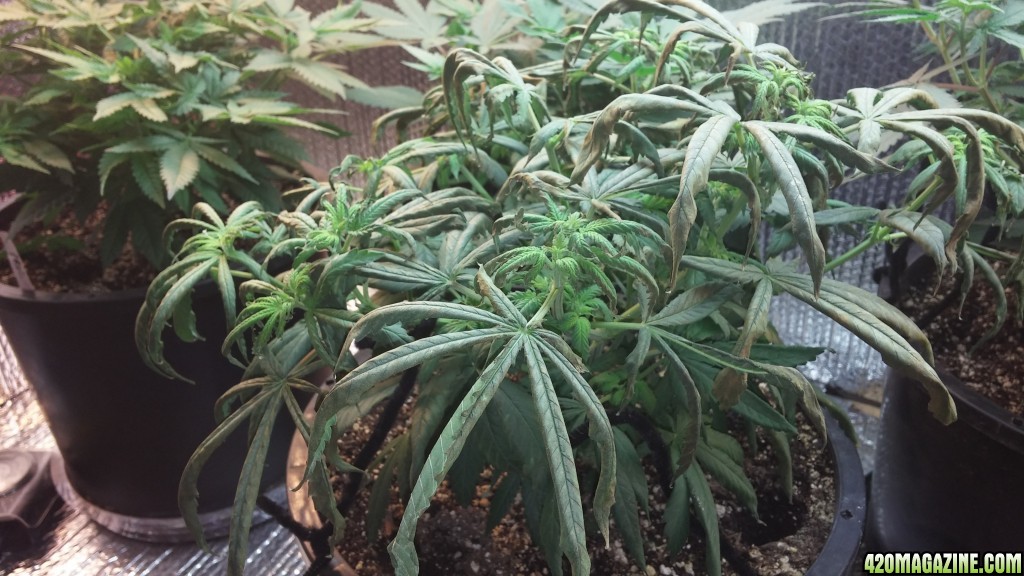DLS is for flower.... you're already flowering?
The Flowering Schedule
Plants that have been grown up using the Gas Lantern Routine are now supercharged with floral hormones, and ready to go into flower with the slightest provocation. The interruption of the dark period has been destroying enough of the naturally building hormones to keep the plant from flowering, and the well-rested plant now has plenty of stored nutrients and energy to finish its life cycle and flower. Triggering the plants is essentially just a matter of removing the interrupting light period, so the plants may now experience the full buildup of hormones that will trigger blooming.
In keeping with providing all the correct organic biological and environmental needs of the plant, the diminishing fall schedule should be employed to take full advantage of the hormonal preparation created by using the Gas Lantern Routine. The diminishing hours of light in nature trigger acceleration in the production of hormones in the plant, making it flower with increasing speed and power.
The Diminishing Lighting Schedule
The diminishing fall schedule begins with an evenly halved light schedule, using 12 hours for the first two weeks to trigger the plant into bloom, and then further reducing the lighting for increasing darkness time by one half hour every week.
The final week of flowering will provide the plants with a mere nine hours of light, with 15 hours of darkness, forcing a resulting final explosive hormonal buildup. This sends the plant into blooming overdrive and produces resin far beyond the normal plant’s limits.
When the Gas Lantern Routine and Diminishing Light Schedule are used together, they create healthier, more naturally robust plants. These important and historical botanical techniques are soon going to become very important techniques in the coming years as medicinal cannabis research continues to advance. When viewed from cost of production, organics, and medicinal needs, the methods currently being promoted can be seen counter to the interests of growing healthy plants. Understanding your plants is the best way to grow the best medicine, and looking for solutions to growing problems by observing nature always provides the right answers.
The Flowering Schedule
Plants that have been grown up using the Gas Lantern Routine are now supercharged with floral hormones, and ready to go into flower with the slightest provocation. The interruption of the dark period has been destroying enough of the naturally building hormones to keep the plant from flowering, and the well-rested plant now has plenty of stored nutrients and energy to finish its life cycle and flower. Triggering the plants is essentially just a matter of removing the interrupting light period, so the plants may now experience the full buildup of hormones that will trigger blooming.
In keeping with providing all the correct organic biological and environmental needs of the plant, the diminishing fall schedule should be employed to take full advantage of the hormonal preparation created by using the Gas Lantern Routine. The diminishing hours of light in nature trigger acceleration in the production of hormones in the plant, making it flower with increasing speed and power.
The Diminishing Lighting Schedule
The diminishing fall schedule begins with an evenly halved light schedule, using 12 hours for the first two weeks to trigger the plant into bloom, and then further reducing the lighting for increasing darkness time by one half hour every week.
The final week of flowering will provide the plants with a mere nine hours of light, with 15 hours of darkness, forcing a resulting final explosive hormonal buildup. This sends the plant into blooming overdrive and produces resin far beyond the normal plant’s limits.
When the Gas Lantern Routine and Diminishing Light Schedule are used together, they create healthier, more naturally robust plants. These important and historical botanical techniques are soon going to become very important techniques in the coming years as medicinal cannabis research continues to advance. When viewed from cost of production, organics, and medicinal needs, the methods currently being promoted can be seen counter to the interests of growing healthy plants. Understanding your plants is the best way to grow the best medicine, and looking for solutions to growing problems by observing nature always provides the right answers.



 After I hit the end of week 6 I have been reducing the on time by an hour every couple of days 18/6, 17/7... until I got to 12/12. I see pistils now, but want to see more before I go to GLR schedule. I am still planning on going outside, but later than last year. I was outside three days from now last year. They didn't declare until after they went out. I will have no males inside or outside this year...
After I hit the end of week 6 I have been reducing the on time by an hour every couple of days 18/6, 17/7... until I got to 12/12. I see pistils now, but want to see more before I go to GLR schedule. I am still planning on going outside, but later than last year. I was outside three days from now last year. They didn't declare until after they went out. I will have no males inside or outside this year...

 Battlestar Gallactica ring a bell? I had another small, but easily solved problem. Apparently I over-watered one of my plants.
Battlestar Gallactica ring a bell? I had another small, but easily solved problem. Apparently I over-watered one of my plants.









